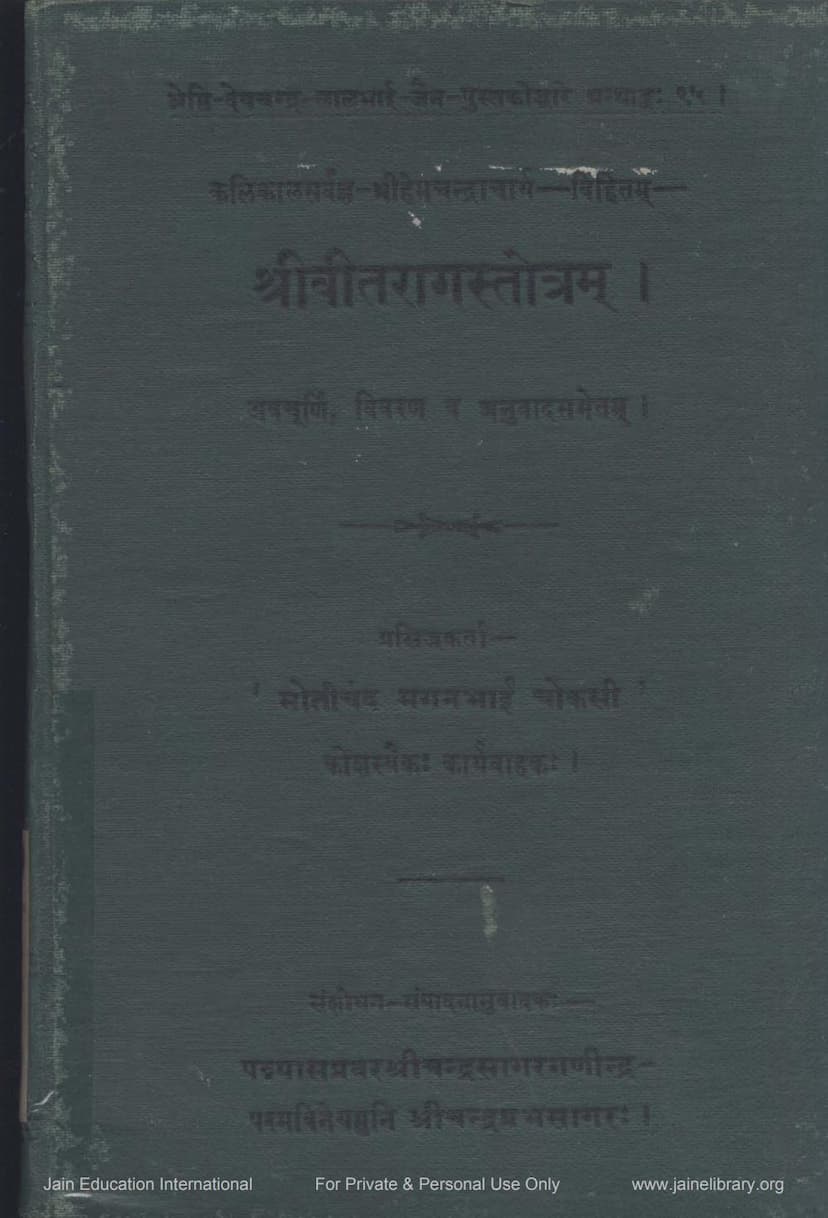Vitrag Stotram
Added to library: September 2, 2025

Summary
This document is a summary of the Vitrag Stotram, a Jain devotional hymn composed by the renowned scholar Hemchandracharya. The text itself is presented with a commentary (Avachurni) by Somodaya Gani and a further explanation (Vivaran) by Prabhānandasuri. The publication also includes a Gujarati translation of the original verses.
The preface highlights the rich, though often unpreserved, legacy of Jain literature, attributing the current project to the Devchand Lalbhai Jain Pustakoddhar Fund. It laments the historical challenges faced by Jain texts due to external factors and internal neglect, emphasizing the fund's mission to rescue and disseminate this valuable literature. The preface also provides a brief history of the fund, established in memory of Sheth Devchand Lalbhai, to promote Jain religious literature.
The core of the Vitrag Stotram is a series of stanzas that praise and describe the qualities of the Tirthankaras, the liberated souls in Jainism, referred to here as the Vitaraagas (those who are free from attachment and aversion). The stotram explores various facets of their glory, which are elaborated upon in the commentaries:
Key Themes and Sections (as indicated by the chapter titles/stanzas):
- The Nature of the Vitaraaga: The stotram begins by extolling the Vitaraaga as the supreme soul (Paratma), the ultimate light (Paranjyoti), and the highest among the Parameshthis (divine beings). They are described as beyond darkness and ignorance, the source of all knowledge, and the destroyer of all afflictions. The hymn expresses devotion and surrender to these liberated beings.
- The Body and Physical Attributes: The stotram details the extraordinary physical characteristics of the Vitaraagas, highlighting their divine radiance, purity, and the absence of any perceived flaws or suffering. This includes descriptions of their bodies being luminous, fragrant, free from illness, and possessing extraordinary beauty.
- The Power of Their Presence: The text emphasizes the transformative effect of the Vitaraaga's presence, which brings peace, dispels negativity, and inspires spiritual growth. Their very existence is described as miraculous and awe-inspiring.
- The Vitaraaga's Actions and Teachings: The stotram celebrates their adherence to Jain principles, their mastery over the senses, their detachment from worldly pleasures and pains, and their role as guides towards liberation. It underscores the power of their teachings and the path they lay out for spiritual attainment.
- The Nature of Jainism vs. Other Philosophies: The commentaries engage in refutations of other philosophical schools (like Buddhism, Sankhya, Nyaya, Vaisheshika, and Charvaka) that do not align with Jain principles. They argue for the necessity of the concept of "Anekanta" (non-absolutism) and criticize views that are contradictory or lack logical grounding.
- The Importance of the Present Era (Kalyuga): The stotram acknowledges the challenges of the current age but paradoxically highlights its potential for spiritual advancement through devotion to the Vitaraaga. It suggests that in this era, spiritual merit can be attained more readily.
- Devotion and Surrender: The stotram expresses deep devotion, surrender, and aspiration for the spiritual progress of the devotee. It emphasizes the futility of worldly desires and the ultimate salvation found in devotion to the Vitaraaga.
- Praise and Supplication: The hymn is filled with expressions of praise for the Vitaraaga's omnipotence, compassion, and liberation. It includes prayers for purification, spiritual guidance, and the eradication of negative tendencies.
- The Power of the Vitaraaga's Teachings: The commentaries delve into the philosophical underpinnings of the stotram, explaining complex Jain doctrines like karma, liberation, the nature of the soul, and the principles of right faith, knowledge, and conduct.
Key Commentators:
- Somodaya Gani: Authored the Avachurni, providing a detailed explanation of the stotram.
- Prabhānandasuri: Composed the Vivaran, offering further insights and interpretations.
- Munishri Chandraprabhasagar: Edited, researched, and translated the original text and commentaries, making it accessible to a wider audience.
The Vitrag Stotram is thus presented as a profound and comprehensive devotional work that not only praises the highest spiritual beings but also serves as a guide to understanding and practicing the core tenets of Jainism.